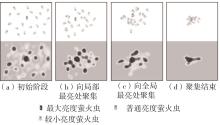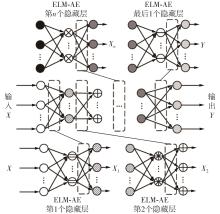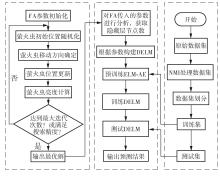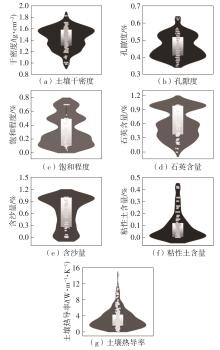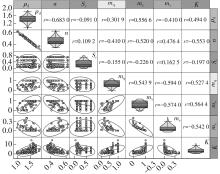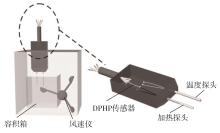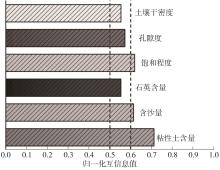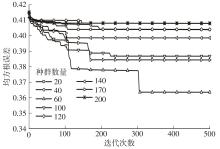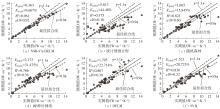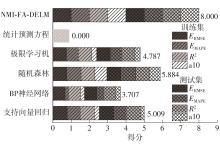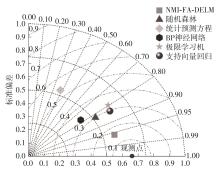Journal of South China University of Technology(Natural Science Edition) ›› 2023, Vol. 51 ›› Issue (9): 129-138.doi: 10.12141/j.issn.1000-565X.220746
• Architecture & Civil Engineering • Previous Articles Next Articles
Prediction of Soil Thermal Conductivity Based on NMI-FA-DELM Model
LEI Yu HUANG Yifan LUO Xuedong ZHOU Shengtao FU Chao
- Faculty of Engineering,China University of Geosciences,Wuhan 430074,Hubei,China
-
Received:2022-11-13Online:2023-09-25Published:2023-03-15 -
Contact:罗学东(1971-),男,教授,主要从事岩土工程研究。 E-mail:cugluoxd@foxmail.com -
About author:雷宇(1998-),男,博士生,主要从事岩土工程和机器学习研究。E-mail:cugleiyu@cug.edu.cn -
Supported by:the National Natural Science Foundation of China(42072309)
CLC Number:
Cite this article
LEI Yu, HUANG Yifan, LUO Xuedong, et al.. Prediction of Soil Thermal Conductivity Based on NMI-FA-DELM Model[J]. Journal of South China University of Technology(Natural Science Edition), 2023, 51(9): 129-138.
share this article
Table 1
Data set[23-27]"
| 序号 | 岩石种类 | ρd/(g·cm-3) | n/% | Sr/% | mq/% | ms/% | mc/% | K/(W·m-1·K-1) |
|---|---|---|---|---|---|---|---|---|
| 1 | 淤泥质土壤 | 1.22 | 0.55 | 0.10 | 0.51 | 0.33 | 0.10 | 0.80 |
| 2 | 淤泥质土壤 | 1.22 | 0.55 | 0.25 | 0.51 | 0.33 | 0.10 | 1.73 |
| 3 | 淤泥质土壤 | 1.22 | 0.55 | 0.50 | 0.51 | 0.33 | 0.10 | 2.06 |
| 4 | 淤泥质土壤 | 1.22 | 0.55 | 0.70 | 0.51 | 0.33 | 0.10 | 3.00 |
| 5 | 沙质土壤 | 1.49 | 0.45 | 0.10 | 0.61 | 0.61 | 0.05 | 0.88 |
| 6 | 沙质土壤 | 1.49 | 0.45 | 0.25 | 0.61 | 0.61 | 0.05 | 2.70 |
| 7 | 沙质土壤 | 1.49 | 0.45 | 0.50 | 0.61 | 0.61 | 0.05 | 2.65 |
| ︙ | ︙ | ︙ | ︙ | ︙ | ︙ | ︙ | ︙ | ︙ |
| 256 | 丰浦砂 | 1.64 | 0.38 | 0.10 | 0.87 | 1.00 | 0.00 | 9.31 |
| 257 | 丰浦砂 | 1.59 | 0.40 | 0.10 | 0.87 | 1.00 | 0.00 | 8.56 |
Table 2
Soil thermal conductivity prediction effect evaluation index table"
| 预测模型 | ERMSE | EMAPE | R2 | a10 | |||||
|---|---|---|---|---|---|---|---|---|---|
| 取值 | 得分 | 取值/% | 得分 | 取值 | 得分 | 取值 | 得分 | ||
| 训练集 | NMI-FA-DELM | 0.359 | 1.000 | 10.180 | 1.000 | 0.961 | 1.000 | 0.90 | 1.000 |
| 统计预测方程 | 5.974 | 0.000 | 45.860 | 0.000 | 0.357 | 0.000 | 0.14 | 0.000 | |
| 极限学习机 | 1.789 | 0.745 | 22.789 | 0.646 | 0.807 | 0.745 | 0.34 | 0.263 | |
| 随机森林 | 1.700 | 0.761 | 17.910 | 0.783 | 0.817 | 0.761 | 0.64 | 0.657 | |
| BP神经网络 | 2.216 | 0.669 | 39.358 | 0.182 | 0.761 | 0.668 | 0.30 | 0.210 | |
| 支持向量回归 | 1.546 | 0.788 | 20.679 | 0.705 | 0.833 | 0.788 | 0.34 | 0.263 | |
| 测试集 | NMI-FA-DELM | 0.363 | 1.000 | 9.667 | 1.000 | 0.961 | 1.000 | 0.92 | 1.000 |
| 统计预测方程 | 5.813 | 0.000 | 44.480 | 0.000 | 0.375 | 0.000 | 0.16 | 0.000 | |
| 极限学习机 | 1.795 | 0.737 | 22.714 | 0.625 | 0.807 | 0.737 | 0.38 | 0.289 | |
| 随机森林 | 1.665 | 0.761 | 15.845 | 0.822 | 0.821 | 0.761 | 0.60 | 0.578 | |
| BP神经网络 | 2.130 | 0.675 | 31.475 | 0.373 | 0.766 | 0.667 | 0.36 | 0.263 | |
| 支持向量回归 | 1.521 | 0.787 | 20.723 | 0.682 | 0.836 | 0.786 | 0.32 | 0.210 | |
| 1 | 李毅,邵明安,王文焰,等 .质地对土壤热性质的影响研究[J].农业工程学报,2003,19(4):62-65. |
| LI Yi, SHAO Mingan, WANG Wenyan,et al .Influence of soil textures on the thermal properties[J].Transactions of the Chinese Society of Agricultural Engineering,2003,19(4):62-65. | |
| 2 | 陆森,任图生 .不同温度下的土壤热导率模拟[J].农业工程学报,2009,25(7):13-18. |
| LU Sen, REN Tusheng .Model for predicting soil thermal conductivity at various temperatures[J].Transactions of the Chinese Society of Agricultural Engineering,2009,25(7):13-18. | |
| 3 | 刘晨晖,周东,吴恒 .土壤热导率的温度效应试验和预测研究[J].岩土工程学报,2011,33(12):1877-1886. |
| LIU Chen-hui, ZHOU Dong, WU Heng .Measurement and prediction of temperature effects of thermal conductivity of soils[J].Chinese Journal of Geotechnical Engineering,2011,33(12):1877-1886. | |
| 4 | 陆森,任图生,杨泱,等 .多针热脉冲技术测定土壤热导率误差分析[J].农业工程学报,2010,26(6):20-25. |
| LU Sen, REN Tusheng, YANG Yang,et al .Error analysis of multi-needle heat pulse probe for soil thermal conductivity measurement[J].Transactions of the Chinese Society of Agricultural Engineering,2010,26(6):20-25. | |
| 5 | 杜宜臻,李韧,吴通华,等 .土壤热导率的研究现状及其进展[J].冰川冻土,2015,37(4):1067-1074. |
| DU Yizhen, LI Ren, WU Tonghua,et al .Study of soil thermal conductivity:research status and advances[J].Journal of Glaciology and Geocryology,2015,37(4):1067-1074. | |
| 6 | 曾召田,范理云,莫红艳,等 .土壤热导率的影响因素实验研究[J].太阳能学报,2018,39(2):377-384. |
| ZENG Shaotian, FAN Liyun, MO Hongyan,et al .Experimental study of influence factors of soil thermal conductivity[J].Acta Energiae Solaris Sinica,2018,39(2):377-384. | |
| 7 | LIU Y, LI K Q, LI D A Q,et al .Coupled thermal-hydraulic modeling of artificial ground freezing with uncertainties in pipe inclination and thermal conductivity[J].Acta Geotechnica,2022,17(1):257-274. |
| 8 | YU X X, ZHENG G, ZHOU H Z,et al .Influence of geosynthetic reinforcement on the progressive failure of rigid columns under an embankment load [J].Acta Geotechnica,2021,16(9):3005-3012. |
| 9 | 王卫华,蔡礼良,龚一丹 .土壤热导率影响因素及模型评估研究[J].华南农业大学学报,2020,41(5):124-132. |
| WANG Weihua, CAI Liliang, GONG Yidan .Research on influencing factors and model assessment of soil thermal conductivity[J].Journal of South China Agricultural University,2020,41(5):124-132. | |
| 10 | WIENER O .Abhandl math-phys Kl Konigl SachsischenGes[M].Leipizig:Klasse.Sachs Akad.Wiss,1912:509. |
| 11 | VRIES D .The physics of plant environments-science direct[J].Environmental Control of Plant Growth,1963,26(4):5-22. |
| 12 | KERSTEN M S .Laboratory research for the determination of the thermal properties of soils[D].Minneapolis:Minnesota University,1949. |
| 13 | CHEN S X .Thermal conductivity of sands[J].Heat and Mass Transfer,2008,44(10):1241-1246. |
| 14 | RIZVI Z H, ZAIDI H H, AKHTAR S J,et al .Soft and hard computation methods for estimation of the effective thermal conductivity of sands[J].Heat and Mass Transfer,2020,56(6):1947-1959. |
| 15 | ZHANG N, ZOU H F, ZHANG L M,et al .A unified soil thermal conductivity model based on artificial neural network [J] International Journal of Thermal Sciences,2020,155(106414):1-6. |
| 16 | JIANG X F, DUAN H C, LIAO J,et al .Estimation of soil salinization by machine learning algorithms in different arid regions of northwest China [J].Remote Sensing,2022,14(2):347. |
| 17 | MAES F, COLLIGNON A, VANDERMEULEN D,et al .Multimodality image registration by maximization of mutual information [J].IEEE Transactions on Medical Imaging,1997,16(2):87-98. |
| 18 | GANDOMI A H, YANG X S, ALAVI A H .Mixed variable structural optimization using firefly algorithm [J].Computers & Structures,2011,89(23/24):2325-2336. |
| 19 | GANDOMI A H, YANG X S, TALATAHARI S,et al .Firefly algorithm with chaos [J].Communications in Nonlinear Science and Numerical Simulation,2013,18(1):89-98. |
| 20 | 颜学龙,马润平 .基于深度极限学习机的模拟电路故障诊断[J].计算机工程与科学,2019,41(11):1911-1918. |
| YAN Xue-long, MA Run-ping .Fault diagnosis of analog circuits based on depth extreme learning machine[J].Computer Engineering & Science,2019,41(11):1911-1918. | |
| 21 | 商强,杨兆升,李志林,等 .基于相空间重构和RELM的短时交通流量预测[J].华南理工大学学报(自然科学版),2016,44(4):109-114. |
| SHANG Qiang, YANG Zhao-sheng, LI Zhi-lin,et al .Short-term traffic flow prediction based on phase space reconstruction and RELM[J].Journal of South China University of Technology(Natural Science Edition),2016,44(4):109-114. | |
| 22 | 闫嘉,陈飞越,易若男,等 .基于样本分布加权跨域极限学习机的电子鼻漂移补偿[J].华南理工大学学报(自然科学版),2020,48(12):105-113. |
| YAN Jia, CHEN Feiyue, YI Ruonan,et al .Drift compensation for electronic nose based on sample distribution weighting cross domain extreme learning machine[J].Journal of South China University of Technology(Natural Science Edition),2020,48(12):105-113. | |
| 23 | TARNAWSKI V R, MOMOSE T, MCCOMBIE M L,et al .Canadian field soils Ⅲ.thermal-conductivity data and modeling[J].International Journal of Thermophysics,2015,36(1):119-156. |
| 24 | CHEN S K .Thermal conductivity of sands[J].Heat and Mass Transfer,2008,44(10):1241-1246. |
| 25 | ZHANG N, YU X, PRADHAN A,et al .Thermal conductivity of quartz sands by thermo-time domain reflectometry probe and model prediction[J].Journal of Materials in Civil Engineering,2015,27(12):17-24. |
| 26 | MCCOMBIE M L, TARNAWSKI V R, BOVESECCHI G,et al .Thermal conductivity of pyroclastic soil (pozzolana) from the environs of Rome[J].International Journal of Thermophysics,2017,38:1-15. |
| 27 | TARNAWSKI V R, MCCOMBIE M L, MOMOSE T,et al .Thermal conductivity of standard sands.Part Ⅲ.Full range of saturation[J].International Journal of Thermophysics,2013,34(6):1130-1147. |
| 28 | KARDANI N, BARDHAN A, SAMUI P,et al .Predicting the thermal conductivity of soils using integrated approach of ANN and PSO with adaptive and time-varying acceleration coefficients[J].International Journal of Thermal Sciences,2022,173:107427/1-15. |
| 29 | ARABGOL S, KO H S .Application of artificial neural network and genetic algorithm to healthcarewaste prediction[J].Journal of Artificial Intelligence & Soft Computing Research,2013,3(4):243-250. |
| 30 | SANG Y J, LIU G, HORTON R .Wind effects on soil thermal properties measured by the dual-probe heat pulse method [J].Soil Science Society of America Journal,2020,84(2):414-424. |
| 31 | FORMAN E, PENIWATI K. Aggregating individual judgments and priorities with the analytic hierarchy process [J].European Journal of Operational Research,1998,108(1):165-169. |
| 32 | YIN X, LIU Q, HUANG X,et al .Perception model of surrounding rock geological conditions based on TBM operational big data and combined unsupervised-supervised learning[J].Tunnelling and Underground Space Technology,2022,120:104285/1-15. |
| 33 | LIU Y .Incomplete big data imputation mining algorithm based on BP neural network [J].Journal of Intelligent and Fuzzy Systems,2019,37(4):4457-4466. |
| 34 | ZHOU J, QIU Y G, ARMAGHANI D J,et al .Predicting TBM penetration rate in hard rock condition:A comparative study among six XGB-based metaheuristic techniques[J].Geoscience Frontiers,2021,12(3):1-9. |
| 35 | LEI Y, ZHOU S T, LUO X D,et al.,A comparative study of six hybrid prediction models for uniaxial compressive strength of rock based on swarm intelligence optimization algorithms[J].Frontiers in Earth Science,2022,10(1):1-11. |
| 36 | CIESIELKI M J, KALLA P, ASKAR S .Taylor expansion diagrams[C]∥ Proceedings of the IEEE Computer Society PUB769.Washington,DC:IEEE,2006,55:1188-1201. |
| [1] | TAO Wenbin, TAO Jie, HOU Junling, et al. In-Situ Stress Characteristics and Optimal Support Design of Deep Roadway#br# [J]. Journal of South China University of Technology (Natural Science Edition), 2020, 48(4): 28-37. |
| [2] | YAN Jia, CHEN Feiyue, YI Ruonan, et al. Drift Compensation for Electronic Nose Based on Sample Distribution Weighting Cross Domain Extreme Learning Machine [J]. Journal of South China University of Technology (Natural Science Edition), 2020, 48(12): 105-113. |
| [3] | XU Yuge LAI Chunling LUO Fei . Bagging Ensemble Fault Diagnosis Modeling with Imbalanced classification in Wastewater Treatment Plant [J]. Journal of South China University of Technology (Natural Science Edition), 2018, 46(8): 107-115. |
| [4] | SHANG Qiang YANG Zhao-sheng LI Zhi-lin LI Lin QU Xin. Short-Term Traffic Flow Prediction Based on Phase Space Reconstruction and RELM [J]. Journal of South China University of Technology (Natural Science Edition), 2016, 44(4): 109-114. |
| [5] | Yu Hong-tao Gao Li-qun Han Xi-chang. Discrete Artificial Firefly Algorithm for Solving Traveling Salesman Problems [J]. Journal of South China University of Technology (Natural Science Edition), 2015, 43(1): 126-131,139. |
| Viewed | ||||||
|
Full text |
|
|||||
|
Abstract |
|
|||||


